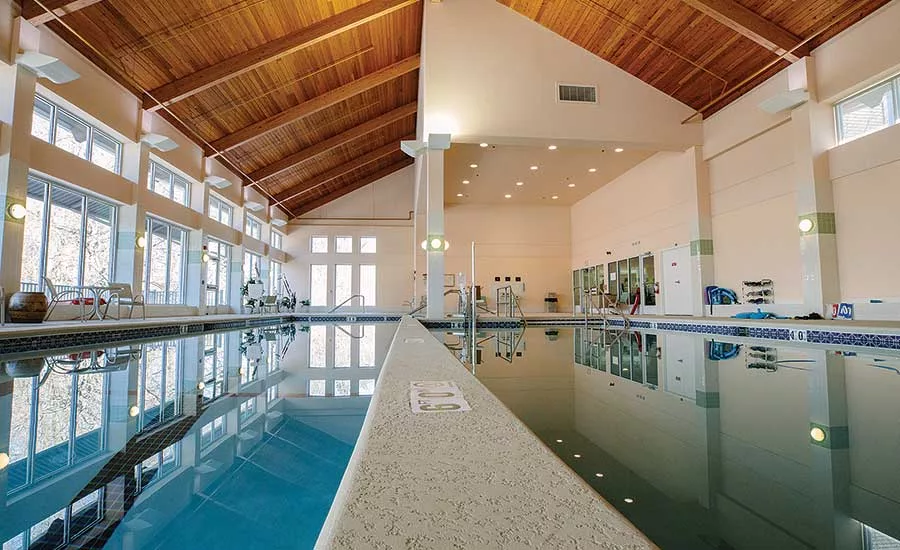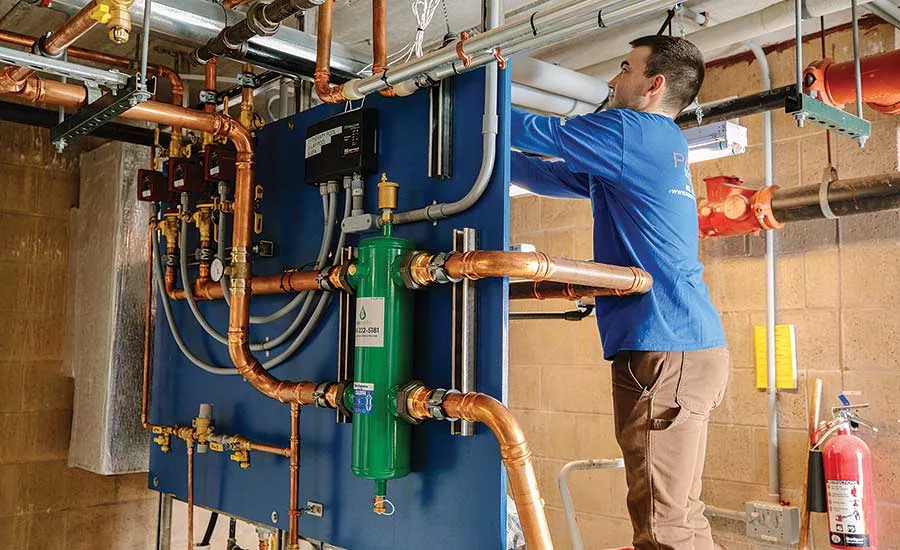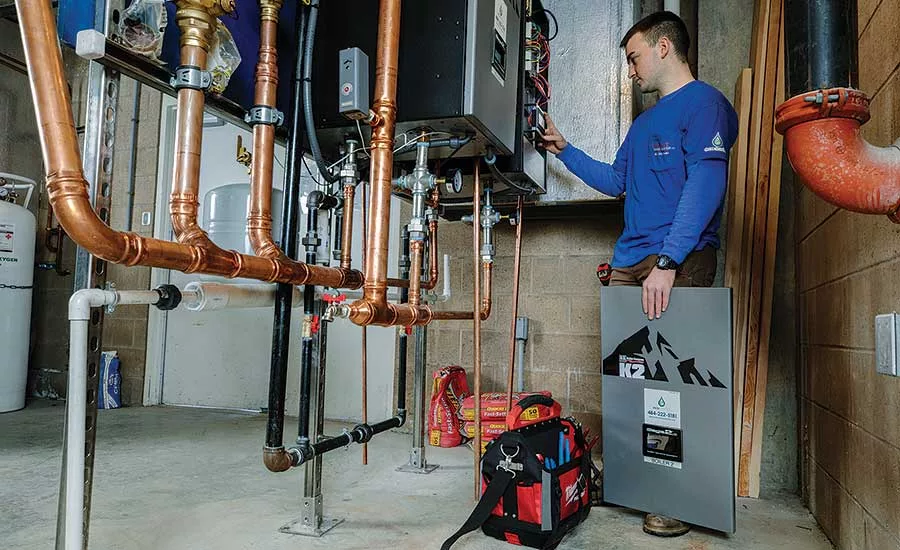Aquatics meets hydronics
Using condensing boilers to heat swimming pools.

The pool heating retrofit at Kendal-Crosslands included a lap pool, therapy pool and spa.

Apprentice Ben Dyson works to install two condensing boilers.

Apprentice Ben Dyson changes setpoints on a K2 condensing boiler.

Gages are installed near the heat exchangers.
The pool industry — or the aquatics industry as it’s referred to by insiders — shares many similarities with the hydronic heating industry. Water quality is vital. Movement of water is also a consideration that has a profound impact on the system as a whole.
When designing pool heating systems, the efficiency, serviceability and longevity of heating equipment are nearly as important as control and safety.
I’ve been in the plumbing and hydronic heating trade for most of my adult life. Through Patriot Water Heater, a company I founded in 2009, I’ve done work all across the northeast, primarily in New York, New Jersey and Pennsylvania.
Hydronic systems in all variety of new construction projects are becoming a premium solution, niche product. Several years ago, I began to seek out opportunities to grow the hydronic side of the business and ultimately move toward 100% hydronic work. I network more than I advertise, focusing on becoming a resource for engineers, architects and facility managers. I’ve also found ways to apply my skillset outside of conventional hydronic heating.
EcoDronics was born out of that effort. It’s a brand within Patriot Water Heater, concentrated on “unconventional” hy-dronic applications like snowmelt, greenhouse heating and root zone warming and pool heating applications.
I’ve learned since diving into pool heat (pun intended) that there’s great opportunity to improve upon the methods and materials used in traditional pool heating systems. Not surprisingly, hydronics can provide that solution. The most recent and, to date, largest pool heating project I’ve been involved with is a prime example.
SEEKING IMPROVEMENT
I was working on a pool heating system last year when I met Don White, of Wallover Architects. The 30-year-old firm is known internationally as a leader in the aquatics industry. When Wallover Architects was called to renovate the natatorium, pools and replace the filtration systems including several heaters at Kendal-Crosslands Communities — a four-property retirement community — he asked me to collaborate.
“This pool facility was built around 2005,” says Joe Deckman, plant operations supervisor at Kendal-Crosslands. The original equipment has been labor-intensive over the years, requiring ongoing maintenance.”
The project, as bid and contracted, started out as a simple, in-kind replacement of the pool heaters as requested by the owner,” White says. “Ultimately, after hearing Tom’s reasoning to use condensing boilers, they decided to spend more for a much better, long-term solution.”
There are three bodies of water at this facility, all maintained at different temperatures: A 31,000-gallon lap pool, a 21,000-gallon therapy pool and a 1,300-gallon spa.
“There was a lot of room for improvement at Kendal-Crosslands,” White says. “The pool heaters were lasting about three years on average, maintaining precise pool temperature was a struggle, fuel consumption was higher than expected and there was no redundancy. If a heater went down, that pool went cold until it was replaced. Exacerbating the issue, the pool heater parts were proprietary and only available from a pool equipment wholesaler.”
“Reducing the maintenance, replacement work and downtime were our priorities,” Deckman says. “But once we start-ed looking at energy savings — a gross reduction of gas input by 52% — I didn’t realize how much we had been leaving on the table. For Kendal-Crosslands, this is more important from an environmental prospective than a financial one. If we can lower our carbon footprint in the process, that’s fantastic.”
AQUATIC CHALLENGES
Pool equipment rooms are often caustic environments. Heating equipment generally shares a mechanical space with concentrated water treatment chemicals, in this case chlorine. I specify only non-ferrous components for use on aquatic installations for this reason.
Because the existing heaters at Kendal-Crosslands were atmospherically vented, they failed quickly. The stand-alone, 80% efficient units were each rated for 250,000 Btu/h. They also suffered from decreased flowrate, resulting in pool temperature swings and short cycling heaters. This was compounded by the fact that all three heaters were oversized, one of them drastically. The end result was an underperforming system that ran very inefficiently and required too much service and frequent component replacement.
My aim was to design and install a system that addressed each of these issues. The best solution is one that’s foreign to the aquatics industry. I specified condensing boilers, a primary-secondary piping system and stainless steel heat ex-changers to isolate the pool water from hydronic system fluid.
UNIQUE SIZING
Months before the actual retrofit took place, I met White and Deckman to discuss the project and calculate the heat load of each body of water. As you might imagine, sizing a pool heat source is a far cry from sizing a boiler for space heating.
The calculation starts with the amount of water in the pool, the surface area of the water and the ambient air temperature (83° F) in the pool area. Combined with the desired setpoint, these figures provide a fixed heat loss.
After deducting the efficiency loss across each of the three DHC shell-and-tube heat exchangers, I found I could provide all the heat needed by the three pools with two, 180 MBH U.S. Boiler Co. K2 high-efficiency boilers. Shell-and-tube heat exchangers were used for low head loss. Had these pools been salt water, or treated with bromine instead of chlorine, titanium heat exchangers would have been selected instead of stainless steel.
HYDRONIC SOLUTION
To speed up the retrofit process, we pre-fabricated much of the near-boiler piping. The heat exchangers — two with a capacity of 250,000 Btu/h and a single 150,000 Btu/h model — were installed where the pool heaters had originally been connected.
I wanted to keep the boilers as far from the chemical storage area as possible. My apprentice, Benjamin Dyson, and I constructed a wall in one corner of the room, keeping the boilers off the floor. Three Grundfos circulators, a Caleffi hy-dro separator and the U.S. Boiler Co. Sage Zone Control panel are installed on the reverse side of the wall.
I chose condensing boilers for this project not only for efficiency, but also because sealed combustion was a must. The K2 boiler has been my go-to model for a number of years because it’s reliable, affordable and easy to service. Adding to that, the controls are intuitive and simple to configure for any application. That was especially important on this job since there was no outdoor reset, in the traditional sense.
Instead of determining supply water temperature based on outdoor air temperature, the boiler control is set to respond to return water temperature. The minimum supply water temperature is 140°, and the boiler control looks to maintain a 20° ΔT.
The K2’s “boost” function is programmed to raise the supply water temperature by 20° every 20 minutes. That’s longer than would typically be used in a residential application. Once the boilers are maintaining heat, I’ve found that it never goes into boost mode for more than 15 minutes, which tells me that the units are condensing almost constantly.
One boiler can handle the load to maintain setpoint temperature if all the pools call for heat simultaneously under normal conditions. The boilers are set up as lead/lag with a 10-minute delay before firing the second unit, which generally happens after a large filter backwash, draining or cleaning. Two boilers were installed instead of one larger unit for re-dundancy. My design met Wallover Architects’ filter design at the heat exchangers.
ACCURACY AND SUCCESS
Immediately before the retrofit, Wallover Architects’ new filtration and water treatment design was installed. The new, VFD-powered filter pumps were chosen to provide the turnover rates required by ANSI Standards for Swimming Pools ANSI/NSPI-1 2003 and ANSI/NSPI-2 1999, American National Standard for Spas.
The lap and therapy pool each need 71 gpm on the pool side of the heat exchanger, while the much smaller spa re-quires 30 gpm. This impacted both the sizing of the heat exchanger and selection of the three “zone” circulators. Source-side flow rates are 4.1, 3.7 and 1.1 gpm, respectively. Flow rates, and the ability to maintain precise setpoint temperatures, are just as important in aquatic applications as in heating systems. Maybe more so.
Per ANSI code, pool temperature setpoints must be maintained within .3° of setpoint temperature. This is critical be-cause as water temperature changes, so does the rate at which chlorine oxidizes. Sanitizer levels (chlorine dilution) must be recorded on an hourly basis. Before the retrofit, Kendal-Crosslands was having trouble with fluctuating pool tempera-tures. Now, the system maintains temperature to .2°.
Maintenance was greatly reduced as a result of the boiler installation. When the boilers are cleaned annually, so are the heat exchangers.
“Traditionally, pool heating systems are installed and maintained by pool companies,” White says. “I think this installation is evidence that savvy hydronic installers with a properly-designed condensing boiler system will become a major disrupter in the aquatics industry in the years to come.”
If more consistent pool temperatures, improved fuel consumption and reduced maintenance aren’t proof that the pro-ject was a success, Kendal-Crosslands’ response is. They’re thrilled with the result and are considering implementation of a similar system at an adjacent property.
Looking for a reprint of this article?
From high-res PDFs to custom plaques, order your copy today!






